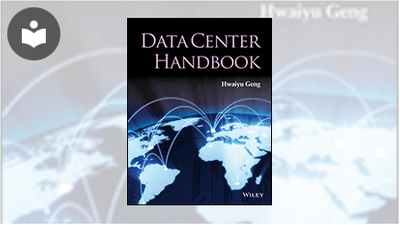Data Center Handbook
- 21h 37m
- Hwaiyu Geng
- John Wiley & Sons (US)
- 2015
Provides the fundamentals, technologies, and best practices in designing, constructing and managing mission critical, energy efficient data centers
Organizations in need of high-speed connectivity and nonstop systems operations depend upon data centers for a range of deployment solutions. A data center is a facility used to house computer systems and associated components, such as telecommunications and storage systems. It generally includes multiple power sources, redundant data communications connections, environmental controls (e.g., air conditioning, fire suppression) and security devices.
With contributions from an international list of experts, The Data Center Handbook instructs readers to:
- Prepare strategic plan that includes location plan, site selection, roadmap and capacity planning
- Design and build “green” data centers, with mission critical and energy-efficient infrastructure
- Apply best practices to reduce energy consumption and carbon emissions
- Apply IT technologies such as cloud and virtualization
- Manage data centers in order to sustain operations with minimum costs
- Prepare and practice disaster reovery and business continuity plan
The book imparts essential knowledge needed to implement data center design and construction, apply IT technologies, and continually improve data center operations.
About the Author
Hwaiyu Geng, P.E. , is a consultant with Amica Association, promoting green planning, design, and construction projects. He has had over 40 years of manufacturing and management experience, working with Westinghouse, Applied Materials, HP, and Intel on multi-million high-tech projects. He has written and presented numerous technical papers at DatacenterDynamics, ASME and IIE conferences, and is also the editor/author of Manufacturing Engineering Handbook (McGraw Hill, 2004), Semiconductor Manufacturing Handbook (McGraw Hill, 2005), and Data Center Handbook (Wiley, 2014). He is a patent holder.
In this Book
-
Chapter Organization
-
Data Centers—Strategic Planning, Design, Construction, and Operations
-
Energy and Sustainability in Data Centers
-
Hosting or Colocation Data Centers
-
Modular Data Centers—Design, Deployment, and other Considerations
-
Data Center Site Search and Selection
-
Data Center Financial Analysis, ROI and TCO
-
Overview of Data Centers in China
-
Overview of Data Centers in Korea
-
Architecture Design—Data Center Rack Floor Plan and Facility Layout Design
-
Mechanical Design in Data Centers
-
Electrical Design in Data Centers
-
Fire Protection and Life Safety Design in Data Centers
-
Structural Design in Data Centers—Natural Disaster Resilience
-
Data Center Telecommunications Cabling
-
Dependability Engineering for Data Center Infrastructures
-
Particulate and Gaseous Contamination in Data Centers
-
Computational Fluid Dynamics Applications in Data Centers
-
Environmental Control of Data Centers
-
Data Center Project Management and Commissioning
-
Virtualization, Cloud, SDN, and SDDC in Data Centers
-
Green Microprocessor and Server Design
-
Energy Efficiency Requirements in Information Technology Equipment Design
-
Raised Floor versus Overhead Cooling in Data Centers
-
Hot Aisle versus Cold Aisle Containment
-
Free Cooling Technologies in Data Centers
-
Rack-Level Cooling and Cold Plate Cooling
-
Uninterruptible Power Supply System
-
Using Direct Current Network in Data Centers
-
Rack PDU for Green Data Centers
-
Renewable and Clean Energy for Data Centers
-
Smart Grid-Responsive Data Centers
-
Data Center Benchmark Metrics
-
Data Center Infrastructure Management
-
Computerized Maintenance Management System in Data Centers
-
Data Center Disaster Recovery and High Availability
-
Lessons Learned from Natural Disasters and Preparedness of Data Centers
YOU MIGHT ALSO LIKE



